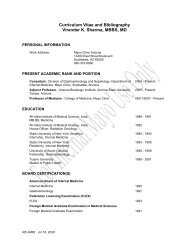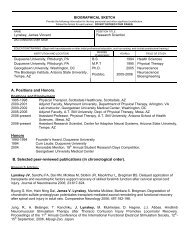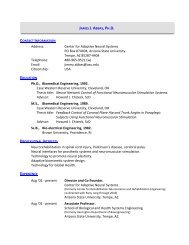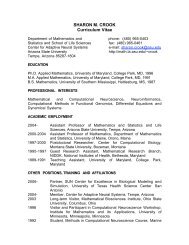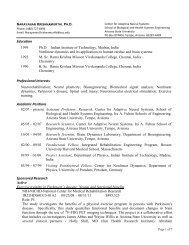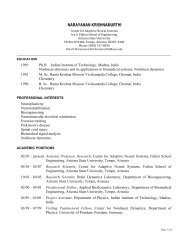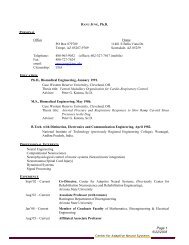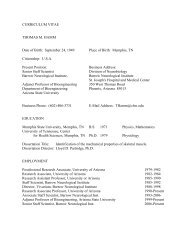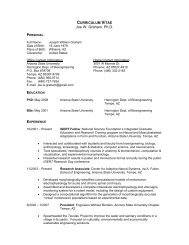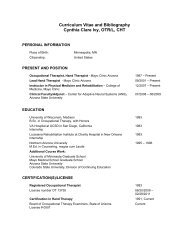ASU FC S 04 - Center for Adaptive Neural Systems - Arizona State ...
ASU FC S 04 - Center for Adaptive Neural Systems - Arizona State ...
ASU FC S 04 - Center for Adaptive Neural Systems - Arizona State ...
You also want an ePaper? Increase the reach of your titles
YUMPU automatically turns print PDFs into web optimized ePapers that Google loves.
For Raupp, the challenge will be coordinating and implementing the center<br />
vision and multi-dimensional strategic plan as the technology comes to fruition.<br />
The Army, academic and industry partners will participate in defining the center<br />
activities though a governing board chaired by George Poste, director of <strong>ASU</strong>’s<br />
<strong>Arizona</strong> Biodesign Institute (AzBio). The research ef<strong>for</strong>t will be led at <strong>ASU</strong> by nine<br />
AzBio and <strong>Center</strong> <strong>for</strong> Solid <strong>State</strong> Electronics Research (CSSER) faculty: Frederic<br />
Zenhausern and Shawn O’ Rourke at AzBio; David Allee, Dieter Schroder and Trevor<br />
Thornton from electrical engineering; Terry Al<strong>for</strong>d and James Mayer along with<br />
newly-recruited Ghassan Jabbour from chemical and materials engineering; and Al<br />
Chasey from the Del E. Webb School of Construction.<br />
“The Army’s Flexible Display <strong>Center</strong> will integrate the best research being done<br />
in the government, universities and industry to rapidly bring to the soldier the full<br />
potential of flexible display technology,” said Acting Deputy Assistant Secretary<br />
Research and Technology, Dr. Thomas H. Killion. “This paradigm shifting technology<br />
will make obsolete printed matter and the printing press.”<br />
The Flexible Display <strong>Center</strong> is a major undertaking by the U.S. Army that is<br />
being launched after an intense, nearly year-long, national merit-based competition.<br />
“This award is further evidence that <strong>ASU</strong> can compete with the nation’s elite institutions<br />
<strong>for</strong> awards of this magnitude and importance on an international scale,” said <strong>ASU</strong><br />
President Michael Crow. “There is keen interest in our capability to develop<br />
advanced technologies, integrate those technologies together into working devices<br />
and deploy them in the most critical and demanding applications. It has enabled us<br />
to compete successfully to get this center against very stiff competition and a rigorous<br />
review process.”<br />
The award is testament to <strong>ASU</strong>’s ability to attract vital resources to the university<br />
and advance high tech-based economic growth in the Valley. The reputation of the<br />
<strong>Arizona</strong> Biodesign Institute (AzBio), where most of the science <strong>for</strong> the flexible<br />
display initiative will be conducted, is key in winning such path-breaking proposals.<br />
The director of AzBio, world-renowned scientist George Poste, said passage last year<br />
of the Research Infrastructure Bill, which allocated $450 million to the state universities<br />
<strong>for</strong> the construction of world-class research infrastructure facilities, was an essential<br />
element in <strong>ASU</strong>’s success.<br />
Key Fulton faculty and researchers involved in this award, shown below (left-right):<br />
Frederic Zenhausern, David Allee, Trevor Thornton, Dieter Schroder and Al Chasey.<br />
Not pictured: Terry Al<strong>for</strong>d, James Mayer and Shawn Orourke.<br />
During a site visit last<br />
September, representatives from<br />
the Army toured <strong>ASU</strong>’s proposed<br />
location <strong>for</strong> the center, a state-ofthe-art<br />
250,000 square foot<br />
multi-functional display manufacturing<br />
R&D facility in the <strong>ASU</strong><br />
Research Park. This headquarters<br />
<strong>for</strong> the new Flexible Display<br />
<strong>Center</strong> includes 43,500 square<br />
feet of advanced clean room<br />
space and extensive wet and dry<br />
labs. <strong>ASU</strong>’s acquisition of this<br />
one-of-a-kind facility will allow a<br />
rapid deployment of physical<br />
infrastructure and start up <strong>for</strong> the<br />
project, a scenario the Army<br />
deemed important to the success<br />
of the project.<br />
In addition to purchasing the<br />
Motorola facility, <strong>ASU</strong> is in midst<br />
of a rapid expansion of its<br />
research infrastructure, with<br />
facilities already purchased,<br />
under construction, and planned,<br />
which will add 1 million sq. ft. of<br />
world-class research space. The<br />
state of <strong>Arizona</strong>, with passage of<br />
the research infrastructure bill<br />
last June, has committed $185<br />
million to <strong>ASU</strong> <strong>for</strong> research facilities<br />
that will attract top scientists<br />
and additional revenue, as well as<br />
spawn new business and industry<br />
in <strong>Arizona</strong>.<br />
Fulton School of Engineering 13



